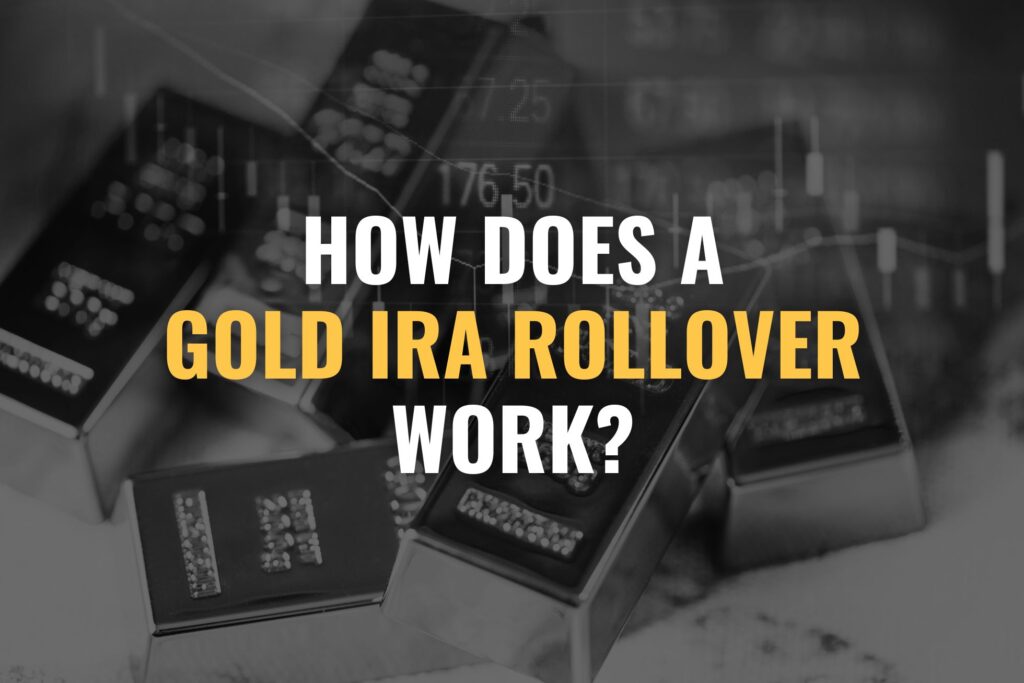What is a Gold IRA Rollover?

If you’re working on building your retirement savings, you likely already have a retirement account in place. Employees at a company often have a 401(k), while those who are self-employed typically opt for an IRA (Individual Retirement Account).
What you might not know is that you can establish a Gold IRA and transfer funds from your existing retirement account to finance it. This process, called a Gold IRA rollover, is what makes Gold IRAs distinct from standard retirement accounts.
In this guide, we’ll explore the details of how Gold IRA rollovers function, what makes them special, and the tax benefits that come with investing in a Gold IRA.
Key Points
- A Gold IRA rollover is the process of moving money from a retirement account, like a 401(k) or standard IRA, into a self-directed IRA that permits investments in physical gold and other precious metals. This strategy helps investors broaden their retirement savings by adding physical assets, such as gold, which may protect against economic ups and downs and rising prices.
- There are two main ways to carry out a Gold IRA rollover. A direct rollover transfers funds straight from the original retirement account to the new Gold IRA without the account owner handling the money, avoiding any tax issues. An indirect rollover involves the account owner withdrawing funds from the existing account and depositing them into the Gold IRA within 60 days. If the transfer isn’t completed within this period, it could lead to taxes and penalties.
- Following IRS rules is essential to keep the tax benefits of the retirement funds intact. Working with a trusted financial advisor or a reliable Gold IRA custodian can offer personalized advice and ensure all legal requirements are met.
Grasping the Concept of IRA Rollovers
A Gold IRA rollover involves moving funds from an existing retirement account, such as a 401(k) or traditional IRA, into a Gold IRA. This allows you to diversify your investments by shifting some of your savings from conventional assets like stocks, bonds, or mutual funds into precious metals.
It’s important to understand that a rollover differs from a transfer in the context of retirement accounts. A transfer involves moving funds between two institutions while keeping the same account type. In contrast, a rollover shifts funds from one type of account to another, such as from a 401(k) to a Gold IRA.
There are two primary methods to execute a rollover from your current retirement account to a Gold IRA:
Direct Rollover
In a direct rollover, the custodian of your existing retirement account works with the institution managing your new Gold IRA to transfer the funds directly. This process is seamless, as you don’t handle the money yourself. The custodians coordinate to ensure the transfer is completed without triggering penalties or taxes, keeping your funds fully compliant with IRS regulations.
Indirect Rollover
An indirect rollover requires you to withdraw funds from your current IRA or 401(k) and then deposit them into your Gold IRA. You might worry that withdrawing funds before retirement age could lead to tax penalties. However, the IRS allows a 60-day window from the date you receive the funds to deposit them into your new Gold IRA. As long as you meet this deadline, the process remains tax and penalty-free.

Why Is a Gold IRA Rollover Distinctive?
Many investors understand the importance of securing reliable savings for retirement. Traditional options like 401(k)s and IRAs provide tax-advantaged accounts, but they typically focus on intangible assets such as stocks and bonds.
In contrast, a Gold IRA rollover allows you to invest in physical gold, which you can physically own. Tangible assets like gold are often considered a more stable investment because they can be held indefinitely without significant loss of value. Moreover, physical assets offer improved risk management, as precious metals like gold tend to retain their worth over time compared to stocks, bonds, or mutual funds, which can be more volatile.
Once you invest in approved coins or bullion bars through a Gold IRA, these assets are stored in secure, third-party vaults, adding an extra layer of protection not typically available with traditional investments. This combination of security and the enduring value of precious metals makes Gold IRA rollovers stand out.
Reasons to Explore a Gold IRA Rollover
To highlight the value of a Gold IRA rollover, here are several compelling reasons to consider investing in precious metals:
Protection Against Inflation and Economic Uncertainty
In times of rising inflation or economic turbulence, gold and other precious metals can safeguard your savings. As the purchasing power of currency declines, gold often holds or even grows in value, providing a stable foundation for your retirement funds.
Minimal Correlation with Conventional Assets
A Gold IRA is an excellent choice for those seeking to reduce risks in their investment portfolio. Gold and other precious metals typically have little correlation with traditional assets like stocks, exchange-traded funds (ETFs), or bonds. This means that when the value of these assets drops, gold often remains steady or appreciates, helping you preserve your retirement savings during market downturns.
Enhanced Diversification
Diversification is a key principle of investing, ensuring your assets aren’t overly concentrated in one area. A Gold IRA supports this strategy by allowing you to allocate your investments across different asset classes. By including precious metals in your portfolio, you can lower the risk of significant losses tied to any single investment type.
How to Complete a Gold IRA Rollover
Now that we’ve covered the benefits of a Gold IRA and the reasons to consider a rollover, let’s walk through the practical steps to make it happen. Below is a clear, step-by-step guide to executing a Gold IRA rollover.
Step 1: Select a Trustworthy Gold IRA Custodian
The first step in a Gold IRA rollover is choosing a custodian for your new account. The custodian will manage your gold investments, arrange secure storage, handle administrative tasks, and oversee the rollover process.
Choosing the right custodian is critical. Look for one with a strong reputation, reasonable fees, and positive feedback from clients. Research well-established options, such as reputable firms known for reliability, to ensure your investments are in good hands.
Step 2: Establish Your Gold IRA
Next, partner with a gold IRA company to open your account. The criteria for selecting a company are similar to those for choosing a custodian. Prioritize firms that:
- Charge fair and transparent fees.
- Have a solid reputation for excellent customer service.
- Demonstrate expertise in setting up Gold IRAs.
Once you’ve chosen a company, follow their guidance to complete the account setup process and prepare for the rollover.
Step 3: Coordinate the Rollover with Your Custodian
With your Gold IRA established, the final step is to transfer funds from your existing retirement account. Your Gold IRA custodian will work with the custodian of your current account (such as a 401(k) or traditional IRA) to facilitate the process.
They will handle the transfer, which can be done via a direct rollover (funds move directly between accounts) or an indirect rollover (you receive the funds and deposit them within 60 days). Once the transfer is complete, you can begin investing in IRS-approved precious metals, such as gold coins or bullion bars.
Tax Considerations for a Gold IRA Rollover
One of the advantages of a Gold IRA rollover is that it generally involves minimal tax consequences when done correctly. The primary tax concern to be aware of is the early withdrawal penalty.

If you withdraw or distribute funds from your Gold IRA before reaching retirement age, the IRS may impose an additional 10% tax on the withdrawal amount. This penalty can inadvertently apply during an indirect rollover. In an indirect rollover, funds are withdrawn from your existing IRA or 401(k) and sent to you, and you must deposit them into your Gold IRA within 60 days. Failing to meet this deadline could trigger the early withdrawal penalty, increasing your tax liability.
To avoid this risk, we recommend opting for a direct rollover. In this method, funds move directly from your current retirement account to your Gold IRA without passing through your hands, eliminating the risk of penalties and ensuring a smooth, tax-free transfer.
Managing Your Gold IRA After the Rollover
Some new Gold IRA investors assume their work is complete once they’ve transferred funds and selected their precious metals for investment. They may think that choosing metals and a secure storage facility is the final step. However, this is far from the truth.
Ongoing management of your Gold IRA is just as critical as the initial investment decisions. Your custodian plays a key role here, tracking the performance and value of your assets to help determine if they remain suitable for your portfolio. Regularly reviewing your holdings is essential, especially since the spot market prices of precious metals can fluctuate significantly in the short term.
By actively monitoring and rebalancing your portfolio based on market trends, you can position yourself to maximize returns when you eventually withdraw funds from your retirement account.
Conclusion
A Gold IRA rollover is a powerful tool for enhancing your retirement strategy. The value that gold and other precious metals bring to your investment portfolio cannot be overstated.
These assets not only diversify your holdings but also serve as a reliable shield against inflation, which is particularly valuable in today’s unpredictable economic environment.
For a secure financial future, we encourage you to consult with a financial expert to explore the long-term benefits of incorporating gold into your retirement plan. Research the best gold IRA companies to guide you through the rollover process and help you make informed decisions.
